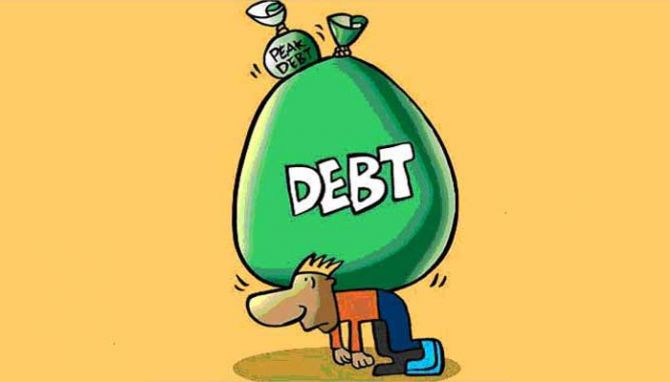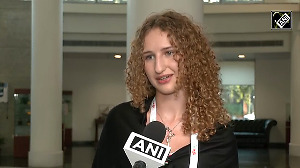In the past three years, personal loans have grown at twice the rate of growth in personal disposable income, leading to a steady rise in household indebtedness.
At the end of March this year, Indians owed Rs 25.2 lakh crore to banks and listed non-banking finance companies (NBFCs), up 65 per cent in the past three years.
Krishna Kant reports.
Illustration: Uttam Ghosh/Rediff.com

A rising share of consumption in India's economic growth has begun to strain the balance sheets of individuals and families as a bulk of the incremental consumption expenditure is being financed through personal loans rather than growth in income.
In the past three years, personal loans have grown at twice the rate of growth in personal disposable income, leading to a steady rise in household indebtedness.
At the end of March this year, Indians owed Rs 25.2 lakh crore to banks and listed non-banking finance companies (NBFCs), up 65 per cent in the past three years.
Outstanding personal loans are now equivalent to 18.3 per cent of India's national disposable income, up from 15 per cent in FY14 and a 10-year-low of 14.1 per cent in FY12.
In the past three years, personal loans or household debt has grown at a compounded annual growth rate (CAGR) of 18 per cent against 10.2 per cent CAGR in India's gross national disposable income (at current prices) during the period, according to Reserve Bank of India (RBI) figures.
National Personal Disposable Income (NPDI) is the part of the gross national income that accrues to households or individuals in the forms of salaries and wages, profits, dividends on shares, interest on bank deposits & bonds, government subsidy and income from abroad net of taxes paid to the government.
In FY17, NPDI was equivalent to 90 per cent of India's gross domestic product (GDP) at market prices.
The analysis is based on the outstanding personal loans of commercial banks as provided by the RBI and the balance sheets of listed retail NBFCs that are part of the BSE 500, BSE Mid Cap and BSE Small Cap indices.
Some of the NBFCs in the Business Standard sample include Housing Development Finance Corporation (HDFC), LIC Housing Finance, Dewan Housing Finance, Bajaj Finance, M&M Finance, Shriram Transport, Bharat Financial Inclusion, Manappuram Finance and Muthoot Finance, among others.
Earlier this week, RBI had raised concerns about the growing share of final consumption expenditure, both private and government, in India's incremental GDP growth in its annual report for FY17.
According to the central bank, this may result in higher household indebtedness that may threaten the sustainability of India's growth model in the longer term.
"Consumption-led growth did have, albeit not statistically significant, a negative impact on consumption growth one year ahead. These results corroborate the imperative for a judicious balance in the growth drivers for non-disruptive and sustainable long-term growth," concludes the RBI in its annual report.
The central bank's fears were based on a US study (Dynan 2012) which highlighted the negative aspect of consumption-led growth.
"Consumption-led growth can arguably lead to a slackening of future growth if it entails growing imbalances due to limits to capacity creation, and rising debt burdens, particularly for households. Evidently, while borrowings helped smoothen private consumption in the short-run after the recession of 2001-02, excessive leverage led to the debt-servicing burden which, in turn, debilitated consumption and overall growth during 2007 to 2009 in the US," concludes Karen Dynan in her study.
Private final consumption expenditure accounted for 67 per cent of the India's GDP growth at constant prices in FY17 while government expenditure contributed another 28 per cent.
The numbers were 45 per cent and 4.5 per cent, respectively, in FY16 according to GDP data.
Analysts fear a similar slowdown in India given the growing mismatch between household debt and their income and financial savings.
"Household debt has been consistently growing faster than both personal income including salaries & wages and their financial savings. This could put a sudden brake on consumption growth either if retail inflation spikes or there is a sharp depreciation in rupee," said Dhananjay Sinha, head of research, Emkay Global Financial Services.
He also foresaw risks to current account deficit due to an unsustainable growth in consumption expenditure starting a vicious cycle of higher current account deficit and lower rupee.












 © 2025
© 2025